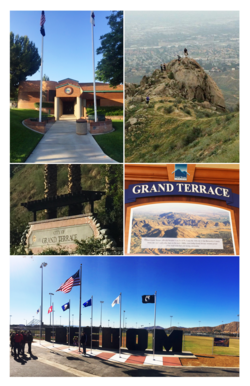2020
The 2020 United States census reported that Grand Terrace had a population of 13,150. The population density was 3,753.9 inhabitants per square mile (1,449.4/km2). The racial makeup of Grand Terrace was 44.5% White, 6.9% African American, 1.7% Native American, 6.5% Asian, 0.4% Pacific Islander, 23.1% from other races, and 16.9% from two or more races. Hispanic or Latino of any race were 47.9% of the population. [13]
The census reported that 98.9% of the population lived in households, 0.8% lived in non-institutionalized group quarters, and 0.3% were institutionalized. [13]
There were 4,695 households, out of which 34.6% included children under the age of 18, 48.2% were married-couple households, 7.4% were cohabiting couple households, 27.8% had a female householder with no partner present, and 16.5% had a male householder with no partner present. 22.3% of households were one person, and 10.1% were one person aged 65 or older. The average household size was 2.77. [13] There were 3,345 families (71.2% of all households). [14]
The age distribution was 21.5% under the age of 18, 9.5% aged 18 to 24, 28.0% aged 25 to 44, 24.1% aged 45 to 64, and 16.9% who were 65 years of age or older. The median age was 38.1 years. For every 100 females, there were 92.9 males. [13]
There were 4,898 housing units at an average density of 1,398.2 units per square mile (539.8 units/km2), of which 4,695 (95.9%) were occupied. Of these, 62.1% were owner-occupied, and 37.9% were occupied by renters. [13]
In 2023, the US Census Bureau estimated that 14.1% of the population were foreign-born. Of all people aged 5 or older, 64.7% spoke only English at home, 28.9% spoke Spanish, 1.7% spoke other Indo-European languages, 3.4% spoke Asian or Pacific Islander languages, and 1.3% spoke other languages. Of those aged 25 or older, 87.0% were high school graduates and 28.5% had a bachelor's degree. [15]
The median household income in 2023 was $83,668, and the per capita income was $36,267. About 4.6% of families and 7.0% of the population were below the poverty line. [16]
2010
The 2010 United States census [17] reported that Grand Terrace had a population of 12,040. The population density was 3,438.0 inhabitants per square mile (1,327.4/km2). The racial makeup of Grand Terrace was 7,912 (65.7%) White (46.4% Non-Hispanic White), [18] 673 (5.6%) African American, 120 (1.0%) Native American, 778 (6.5%) Asian, 32 (0.3%) Pacific Islander, 1,898 (15.8%) from other races, and 627 (5.2%) from two or more races. Hispanic or Latino of any race were 4,708 persons (39.1%).
The census reported that 11,927 people (99.1% of the population) lived in households, 50 (0.4%) lived in non-institutionalized group quarters, and 63 (0.5%) were institutionalized.
There were 4,403 households, of which 1,548 (35.2%) had children under the age of 18 living in them, 2,214 (50.3%) were opposite-sex married couples living together, 599 (13.6%) had a female householder with no husband present, 254 (5.8%) had a male householder with no wife present. There were 285 (6.5%) unmarried opposite-sex partnerships, and 26 (0.6%) same-sex married couples or partnerships. 1,026 households (23.3%) were made up of individuals, and 395 (9.0%) had someone living alone who was 65 years of age or older. The average household size was 2.71. There were 3,067 families (69.7% of all households); the average family size was 3.20.
2,781 people (23.1% of the population) were under the age of 18, 1,244 people (10.3%) aged 18 to 24, 3,320 people (27.6%) aged 25 to 44, 3,195 people (26.5%) aged 45 to 64, and 1,500 people (12.5%) who were 65 years of age or older. The median age was 36.1 years. For every 100 females, there were 92.9 males. For every 100 females age 18 and over, there were 89.6 males.
There were 4,649 housing units at an average density of 1,327.5 per square mile (512.6/km2), of which 2,790 (63.4%) were owner-occupied, and 1,613 (36.6%) were occupied by renters. The homeowner vacancy rate was 1.7%; the rental vacancy rate was 7.0%. 7,848 people (65.2% of the population) lived in owner-occupied housing units and 4,079 people (33.9%) lived in rental housing units.
According to the 2010 United States Census, Grand Terrace had a median household income of $64,073, with 6.5% of the population living below the federal poverty line. [18]





